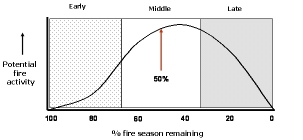Probability Assessment
Probability refers to the likelihood of a fire becoming an active event with potential to adversely affect values.
Time of Season
Evaluate the potential for a long-duration fire and rank this element Low, Moderate or High. Time remaining until a season-ending event should be considered.
Time of Season is the current time in relationship to the historical or peak fire season. The graph reinforces the importance of time of season. During the early part of the fire season, the peak of burning activity is still to come, thus the fire could present substantial variation in behavior and activity. In the middle of the season, the peak of burning activity may or may not have occurred, while in the late part of the season, the peak of fire activity generally has already occurred and managers can reasonably expect diminishing fire activity and behavior as time progresses.
Figure 1: Time of Season Example

The following guidelines can help you determine an appropriate selection for Time of Season:
Table 1: Determining Selection Values for Time of Season
Low (Late)
|
Moderate (Middle)
|
High (Early)
|
- The current date is in the latter part of the historic fire season.
- At least 2/3 of the historic period has passed.
- The peak burning activity period has occurred.
- The probability of a season-ending or fire-ending event is increasing quickly.
- Weather forecasts and seasonal outlooks do not indicate an extended fire season.
|
- The current date is in the middle of the historic fire season.
- At least 1/3 of that period has passed and no less than 1/3 remains.
- The peak burning activity period either has occurred, is occurring now, or will occur very soon.
|
- The current date is in the early portion of the historic fire season.
- At least 2/3 of the established fire season remains.
- The peak of burning activity is still to come.
|
Seasonal Severity
Evaluate fire danger indices and rank this element Low/Moderate, High or Very High/Extreme. Considerations include fire danger indices such as energy release component (ERC), drought status, live fuel moistures, adjective fire danger rating, and geographic area preparedness level.
Use the following table to help guide your selection for Seasonal Severity:
Table 1: Determining Selection Values for Seasonal Severity
Low/Moderate
|
High
|
Very High/Extreme
|
- Measures of fire danger are below or at seasonal averages.
- Drought status is within seasonal norms with no long-term drought present.
- Live and dead fuel moistures are at or higher than seasonal averages.
|
- Measures of fire danger are above seasonal averages, but conditions are not present for large fire growth (measures are below the 90th percentile).
- The area may be experiencing a short-term seasonal drought, but is not considered to be in long-term drought.
- Live and dead fuel moistures are lower than seasonal averages.
|
- Measures of fire danger are or are expected to become well above critical percentiles (typically 90th –97th percentile) seasonal averages, or setting new records.
- The area is considered in a drought situation for more than one year and as much as 3 or more years (long-term drought).
- Live and dead fuel moistures are well below seasonal averages and have reached critical values.
|
Barriers to Fire Spread
Evaluate the barriers to fire spread as a measure of natural defensibility of the fire’s location and an indication of the degree of potential mitigation actions needed and rank this element Low, Moderate or High.
Use the following table to help guide your selection for Barriers to Fire Spread:
Table 1: Determining Selection Values for Barriers to Fire Spread
Low (Many)
|
Moderate
|
High (Few)
|
- Many natural and/or human-made barriers are present and limiting fire spread.
- Ridges, rocky slopes, wide drainages, roads and other fuel breaks will contain the fire along much of its perimeter.
|
- Some barriers are present and limiting fire spread.
- Ridges, rocky slopes, wide drainages, roads, and other fuel breaks will slow or contain the fire along portions of the perimeter.
|
- No barriers are present.
- Few, if any, ridges, rocky slopes, wide drainages, roads and other fuel breaks are present.
|
